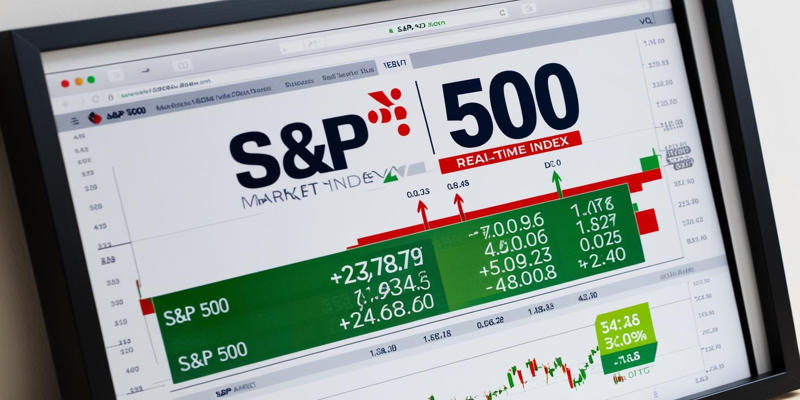Advertisement
From investing in the stock market to building long-term wealth, the S&P 500 index has been a proven way to get broad exposure to the U.S. economy and solid potential for returns over time. Being one of the most followed benchmarks in the stock market, the S&P 500 tracks 500 of the biggest U.S. public companies hailing from different sectors. In this comprehensive guide, you will learn all about how to invest in the S&P 500 today, how to invest in it, the site of the key benefits and risks involved in this process, and finally, some practical steps to build your portfolio.
 Understanding the S&P 500: What It Is and Why It Matters
Understanding the S&P 500: What It Is and Why It MattersThe Standard & Poor's 500, more popularly called the S&P 500, is a stock market index comprising 500 large enterprises listed in the U.S. stock exchanges. To many, it is representative of the performance of the overall U.S. stock market and economy. Understanding this index is essential for any investor to create a diversified portfolio.
The S&P 500 isn't a list of the 500 largest U.S. companies. It's an index selected by a committee based on a few key criteria: Market capitalization of at least $8.2 billion, High trading volume, Public float of at least 10% of outstanding shares, Positive earnings in the most recent quarter and over the past year.
This is a selective process to ensure that the index is representative of a broad cross-section of the U.S. economy across sectors and industries.
The S&P 500 is more than just a representation of the market. Here's why it matters to investors:
There are numerous ways to get exposure to the S&P 500, each with relative advantages and disadvantages. Some of the most common variants will be discussed herein.
Index funds are the most straightforward way to invest in the S&P 500. They are a collection of securities engineered to mimic the performance of this index. They are compositionally made to reflect what is represented in the index. Since they can ensure broad market exposure and an extremely low expense ratio, they would emerge as one of the lucrative instruments for a long-term investor with the goal of passive investing.
S&P 500 ETFs have also become very popular in the last few years. The funds trade on the stock exchanges so investors can buy and sell throughout the trading day. Most ETFs have a lower expense ratio than other mutual funds and are an ideal choice for investors who desire to diversify with the S&P 500 and have the trading aspects of stocks.
For the more sophisticated investor, S&P 500 futures and options contracts provide exposure to the index without having to own the securities. The derivatives enable one to take leveraged positions, hedge, or speculate with more significant risks and are better suited to those with more profound knowledge of more complicated financial instruments.
Indirectly from the S&P 500, another alternative to a direct investment in the index is buying individual stocks of the companies in the index. In this way, investors can select and identify companies that they feel may do better than the overall market. This usually means more research and active management; generally, transaction costs are higher than those of index-based investments.
 Diversification within the index
Diversification within the indexWhile the S&P 500 is diversified, there is a way for savvy investors to optimize their exposure further. For one, the so-called sector rotation- you'd switch your weighting of sectors depending on the economic cycle entails overloading on consumer discretionary and technology in expansions, for example, and moving to more defensive sectors, such as utilities and consumer staples, in contractions.
This age-old, time-tested strategy involves investing a fixed sum of money periodically, irrespective of the ruling market conditions. In the process, you buy more when the prices are low and fewer when they are high, bringing down your average cost per share over time. Investing in the S&P 500 may be done by setting up automated month-on-month investments into some index fund/ETF, smoothing market volatility, and minimizing timing mistakes.
The various sectors and companies that make up the S&P 500 all move differently over time, so your portfolio can drift from your intended allocation. Regular rebalancing, once a year or semiannually- helps keep your desired risk level and investment strategy in place. That means selling some of your best performers and reinvesting in underperforming sectors, which sometimes goes against instinct but often pays off in the long run.
For maximum S&P 500 returns, consider investing in these funds through tax-advantaged accounts such as a 401(k) or IRA. These accounts would house dividends and capital gains free from immediate taxation, thus compounding the efficiency of your investments over time. For taxable accounts, ETFs often have significant tax advantages over mutual funds because of their structure and, typically, lower turnover.
Investing in the S&P 500 is an excellent means of diversification and helps your portfolio grow over a certain period. If you want to learn how to start investing in the S&P 500, here it is:
First, you must choose a way of investing in the S&P 500. The options are multiple:
To invest in the S&P 500, you'll need a brokerage account. Most online brokers offer very user-friendly platforms with relatively low to no minimum investment requirements. A few of the most well-known include:
Compare fees, research tools, and user interface to determine what will work best for your needs.
Once you have your account set up, you can start investing. Here are a few tips:
Therefore, the S&P 500 is among the best options for long-term wealth creation and goals. Understand what the index comprises:ofcomprisesopriate investment vehicles and implement efficient strategies that unlock the growth of America's largest companies. Invhe S&P 500 Index today and take one sure step toward securing your financial future.
Advertisement

By Vicky Louisa/Dec 15, 2024

By Sean William/Jan 01, 2025

By Darnell Malan/Dec 15, 2024

By Mason Garvey/Jan 01, 2025

By Christin Shatzman/Oct 14, 2024

By Susan Kelly/Dec 13, 2024

By Martina Wlison/Dec 26, 2024

By Korin Kashtan/Dec 26, 2024

By Aldrich Acheson/Oct 29, 2024

By Alison Perry/Oct 18, 2024

By Aldrich Acheson/Oct 31, 2024

By Darnell Malan/Dec 25, 2024